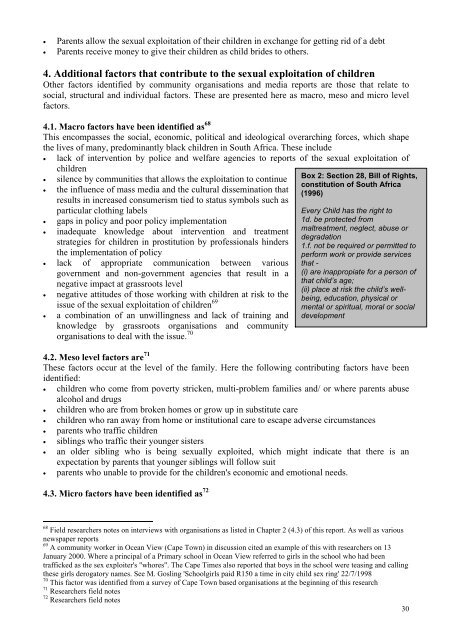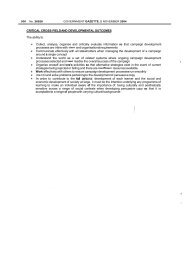The trafficking of children for purposes of sexual exploitation
The trafficking of children for purposes of sexual exploitation
The trafficking of children for purposes of sexual exploitation
Create successful ePaper yourself
Turn your PDF publications into a flip-book with our unique Google optimized e-Paper software.
• Parents allow the <strong>sexual</strong> <strong>exploitation</strong> <strong>of</strong> their <strong>children</strong> in exchange <strong>for</strong> getting rid <strong>of</strong> a debt<br />
• Parents receive money to give their <strong>children</strong> as child brides to others.<br />
4. Additional factors that contribute to the <strong>sexual</strong> <strong>exploitation</strong> <strong>of</strong> <strong>children</strong><br />
Other factors identified by community organisations and media reports are those that relate to<br />
social, structural and individual factors. <strong>The</strong>se are presented here as macro, meso and micro level<br />
factors.<br />
4.1. Macro factors have been identified as 68<br />
This encompasses the social, economic, political and ideological overarching <strong>for</strong>ces, which shape<br />
the lives <strong>of</strong> many, predominantly black <strong>children</strong> in South Africa. <strong>The</strong>se include<br />
• lack <strong>of</strong> intervention by police and welfare agencies to reports <strong>of</strong> the <strong>sexual</strong> <strong>exploitation</strong> <strong>of</strong><br />
<strong>children</strong><br />
• silence by communities that allows the <strong>exploitation</strong> to continue<br />
• the influence <strong>of</strong> mass media and the cultural dissemination that<br />
results in increased consumerism tied to status symbols such as<br />
particular clothing labels<br />
• gaps in policy and poor policy implementation<br />
• inadequate knowledge about intervention and treatment<br />
strategies <strong>for</strong> <strong>children</strong> in prostitution by pr<strong>of</strong>essionals hinders<br />
the implementation <strong>of</strong> policy<br />
• lack <strong>of</strong> appropriate communication between various<br />
government and non-government agencies that result in a<br />
negative impact at grassroots level<br />
• negative attitudes <strong>of</strong> those working with <strong>children</strong> at risk to the<br />
issue <strong>of</strong> the <strong>sexual</strong> <strong>exploitation</strong> <strong>of</strong> <strong>children</strong> 69<br />
• a combination <strong>of</strong> an unwillingness and lack <strong>of</strong> training and<br />
knowledge by grassroots organisations and community<br />
organisations to deal with the issue. 70<br />
Box 2: Section 28, Bill <strong>of</strong> Rights,<br />
constitution <strong>of</strong> South Africa<br />
(1996)<br />
Every Child has the right to<br />
1d. be protected from<br />
maltreatment, neglect, abuse or<br />
degradation<br />
1.f. not be required or permitted to<br />
per<strong>for</strong>m work or provide services<br />
that -<br />
(i) are inappropiate <strong>for</strong> a person <strong>of</strong><br />
that child’s age;<br />
(ii) place at risk the child’s wellbeing,<br />
education, physical or<br />
mental or spiritual, moral or social<br />
development<br />
4.2. Meso level factors are 71<br />
<strong>The</strong>se factors occur at the level <strong>of</strong> the family. Here the following contributing factors have been<br />
identified:<br />
• <strong>children</strong> who come from poverty stricken, multi-problem families and/ or where parents abuse<br />
alcohol and drugs<br />
• <strong>children</strong> who are from broken homes or grow up in substitute care<br />
• <strong>children</strong> who ran away from home or institutional care to escape adverse circumstances<br />
• parents who traffic <strong>children</strong><br />
• siblings who traffic their younger sisters<br />
• an older sibling who is being <strong>sexual</strong>ly exploited, which might indicate that there is an<br />
expectation by parents that younger siblings will follow suit<br />
• parents who unable to provide <strong>for</strong> the <strong>children</strong>'s economic and emotional needs.<br />
4.3. Micro factors have been identified as 72<br />
68 Field researchers notes on interviews with organisations as listed in Chapter 2 (4.3) <strong>of</strong> this report. As well as various<br />
newspaper reports<br />
69 A community worker in Ocean View (Cape Town) in discussion cited an example <strong>of</strong> this with researchers on 13<br />
January 2000. Where a principal <strong>of</strong> a Primary school in Ocean View referred to girls in the school who had been<br />
trafficked as the sex exploiter's "whores". <strong>The</strong> Cape Times also reported that boys in the school were teasing and calling<br />
these girls derogatory names. See M. Gosling 'Schoolgirls paid R150 a time in city child sex ring' 22/7/1998<br />
70 This factor was identified from a survey <strong>of</strong> Cape Town based organisations at the beginning <strong>of</strong> this research<br />
71 Researchers field notes<br />
72 Researchers field notes<br />
30
















